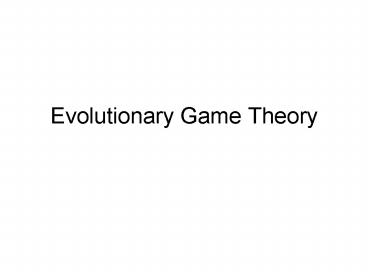Evolutionary Game Theory - PowerPoint PPT Presentation
1 / 20
Title:
Evolutionary Game Theory
Description:
Evolutionary Game Theory Game Theory Von Neumann & Morgenstern (1953) Studying economic behavior Maynard Smith & Price (1973) Why are animal conflicts examples of ... – PowerPoint PPT presentation
Number of Views:96
Avg rating:3.0/5.0
Title: Evolutionary Game Theory
1
Evolutionary Game Theory
2
Game Theory
- Von Neumann Morgenstern (1953)Studying
economic behavior - Maynard Smith Price (1973)Why are animal
conflicts examples of limited wars?
3
Assumptions
- Infinite population size
- Random mating
- Asexual reproduction
- Frequency dependent fitness
- Genotype can be mapped directly onto phenotype -
haplotypes
4
Fundamental Concept
- The Evolutionary Stable Strategy (ESS)A
strategy such that if all members of the
population adopt it, then no mutant can invade
the population under the influence of selection
5
The Haploid Hawk Dove Game
- Consider two haplod virus genotypes that breed
true - The Hawk genotype encodes a virulent virus
strain. - The Dove genotype encodes an avirulent virus
strain
6
Fitness payoffs
- The reproductive value of an infected host to a
virus is V - When two virulent viruses (H) coinfect a host
there is a cost associated with morbidity C - When a virulent virus (H) coinfects with a
avirulent virus (D), H derives all the benefits
V. - When two avirulent viruses (D) infect a host they
obtain approximately half of the resource each V/2
7
Payoff matrix
- H DH 1/2(V-C) VD 0 V/2
8
Building the model
- p frequency of H viruses
- W(H) W(D), denote mean fitness
- E(H,D) fitness payoff to H infecting a body
already infected with D, similar meaning for
E(H,H), E(D,H) and E(D,D) - W0 is the fitness of the virus prior to infection
of the host
9
Virus fitnesses
- Upon infection of a single hostW(H) W0
pE(H,H) (1-p)E(H,D)W(D) W0 pE(D,H)
(1-p)E(D,D)
10
Determining the ESS conditions
- Consider any two genotypes I JW(I) W0
pE(I,J) (1-p)E(I,I)W(J) W0 pE(J,J)
(1-p)E(J,I) - Assume that I is an ESS and J is a rare mutant
with frequency p - If I is an ESS then W(I) gt W(J), assuming that p
ltlt1, then,E(I,I) gt E(J,I) or (Invasion
condition)E(I,I) E(J,I) and E(I,J) gt E(J,J)
(Stability)
11
ESS solutions to the H D game
- E(I,I) gt E(J,I) or (Invasion condition)E(I,I)
E(J,I) and E(I,J) gt E(J,J) (Stability) - E(D,D) gt E(H,D) Never!
- E(H,H) gt E(D,H) only of 1/2(V-C) gt 0
12
Mixed ESS solutions
- What if VltC?
- Does this mean that there is no ESS solution to
the game? - An alternative ESS solution can exist if the
biology permits. - This requires either a genotype capable of
switching between H and D or some mix of H D
coexisting in the population.
13
Mixed ESS solution
- Consider strategy I as genotype H with
probability P and genotype D with probability
(1-P). - For a mixed ESS to exist thenE(A,I) E(B,I)
E(C,I) E(I,I)All pure strategies in support of
I must have the same payoff.
14
Finding the mixed ESS
- If I is a mixed ESS then E(H,I) E(D,I)
- E(H,I) PE(H,H) (1-P)E(H,D)
- E(D,I) PE(D,H) (1-P)E(D,D)
- P(1/2)(V-C) (1-P)V P.0 (1-P)V/2
- Solve for P
- P V/C
15
Testing I with the ESS conditions
- E(I,I) gt E(J,I) or (Invasion condition)E(I,I)
E(J,I) and E(I,J) gt E(J,J) (Stability) - We need to see if I meets the stability
conditionE(H,I) E(D,I) E(I,I) (True) - Therefore we require thatE(I,D) gt E(D,D)
E(I,H) gt E(H,H) - Calculate the above and show that I is an ESS
16
Evolution of virulence genes
- When V gt C then virulent virus always favoured
- When V lt C then some proportion of the population
given by V/C will be virulent - Increasing the cost favours avirulent forms
- Reducing the cost favours the virulent forms
17
Game Theory Summary
- Fitness of a gene can depend on frequencies of
all other genes in a population -- fitness is
frequency dependent - Game theory provides a tool for determining the
equilibrium distribution of genotypes in the
population when fitness is frequency dependent - Key Reference John Maynard Smith.Evolution and
the Theory of Games. CUP. 1982.
18
Game theory anisogamy
19
Game Theory the sex ratio
20
Game theory area of application
- Frequency-dependent selection
- Ignorant about genetic mechanisms
- Parthenogenetic inheritance
- Act as an aid to intuition before building more
complex models - When we do know about genetics it is best to add
selection to our population genetics models

